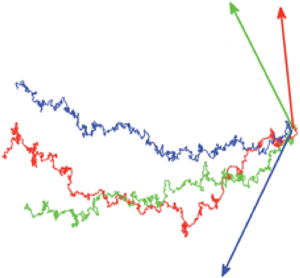Article contents
Stochastic Lagrangian dynamics of vorticity. Part 1. General theory for viscous, incompressible fluids
Published online by Cambridge University Press: 19 August 2020
Abstract

Prior mathematical work of Constantin & Iyer (Commun. Pure Appl. Maths, vol. 61, 2008, pp. 330–345; Ann. Appl. Probab., vol. 21, 2011, pp. 1466–1492) has shown that incompressible Navier–Stokes solutions possess infinitely many stochastic Lagrangian conservation laws for vorticity, backward in time, which generalize the invariants of Cauchy (Sciences mathématiques et physique, vol. I, 1815, pp. 33–73) for smooth Euler solutions. We reformulate this theory for the case of wall-bounded flows by appealing to the Kuz'min (Phys. Lett. A, vol. 96, 1983, pp. 88–90)–Oseledets (Russ. Math. Surv., vol. 44, 1989, p. 210) representation of Navier–Stokes dynamics, in terms of the vortex-momentum density associated to a continuous distribution of infinitesimal vortex rings. The Constantin–Iyer theory provides an exact representation for vorticity at any interior point as an average over stochastic vorticity contributions transported from the wall. We point out relations of this Lagrangian formulation with the Eulerian theory of Lighthill (Boundary layer theory. In Laminar Boundary Layers (ed. L. Rosenhead), 1963, pp. 46–113)–Morton (Geophys. Astrophys. Fluid Dyn., vol. 28, 1984, pp. 277–308) for vorticity generation at solid walls, and also with a statistical result of Taylor (Proc. R. Soc. Lond. A, vol. 135, 1932, pp. 685–702)–Huggins (J. Low Temp. Phys., vol. 96, 1994, pp. 317–346), which connects dissipative drag with organized cross-stream motion of vorticity and which is closely analogous to the ‘Josephson–Anderson relation’ for quantum superfluids. We elaborate a Monte Carlo numerical Lagrangian scheme to calculate the stochastic Cauchy invariants and their statistics, given the Eulerian space–time velocity field. The method is validated using an online database of a turbulent channel-flow simulation (Graham et al., J. Turbul., vol. 17, 2016, pp. 181–215), where conservation of the mean Cauchy invariant is verified for two selected buffer-layer events corresponding to an ‘ejection’ and a ‘sweep’. The variances of the stochastic Cauchy invariants grow exponentially backward in time, however, revealing Lagrangian chaos of the stochastic trajectories undergoing both fluid advection and viscous diffusion.
JFM classification
Information
- Type
- JFM Papers
- Information
- Copyright
- © The Author(s), 2020. Published by Cambridge University Press
References
REFERENCES
- 21
- Cited by

